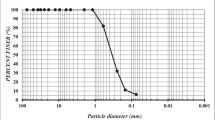Abstract
Alkali-contaminated soils have being considered for research in the recent past to counter the industrial failures encountered due to accidental spillages and leakages. It was observed by the researchers that alkali contamination can change the engineering behavior of the soils to a large extent. The change in soil behavior may alter with the concentration of the alkali, type of soil, and duration of alkali interaction. In the present work, the effect of 2 N and 4 N NaOH on the Unconfined compressive strength (UCS) of BC soil and kaolinite clay was studied for 7, 14, and 28 days. From the results, it was evident that the reduction in UCS values were 46 and 43% for BC soil and 44 and 36% for kaolinite clay with a contamination of 2 N and 4 N NaOH, respectively, after a curing period of 28 days. In order to address this reduction in strength, treatment with 10, 15, and 20% of fly ash was opted for both the soils. In the case of BC soil, 15% fly ash was found to be optimum for 2 N contamination while for 4 N contamination, it was linearly increasing up to 20%. For kaolinite clay, 20% of fly ash addition gave an optimum strength for 2 N contamination and for 4 N contamination, it was observed at 15% fly ash content. The increase in strength can be attributed to the initiation of pozzolanic reaction by alkali and subsequent strength improvement with time due to the formation of pozzolanic compounds.
Access this chapter
Tax calculation will be finalised at checkout
Purchases are for personal use only
Similar content being viewed by others
References
Antiohos S, Tsimas S (2004) Activation of fly ash cementitious systems in the presence of quicklime: Part I. Compressive strength and pozzolanic reaction rate. Cem Concr Res 34(5)
Assa’ad A (1998) Differential upheaval of phosphoric acid storage tanks in Aqaba. Jordan Proc J Perform Constr Facil 12(2):71–76
DiGioia AM, Nuzzo WL (1972) Fly ash as structural fill. J Power Div, ASCE 98(1):77–92
Gray DH, Lin YK (1972) Engineering properties of compacted fly ash. J Soil Mech Found Eng, ASCE 98(4):361–380
Hari Prasad Reddy P, Sivapullaiah PV (2011) Effect of high molar NaOH solutions on fly ash. In: ASCE geotechnical special publication, vol 211, pp 657–666
Leonards A, Bailey B (1982) Closure to pulverized coal ash as structural fill. J Geotech Eng 109(10)
Lew B (2010) A typical case of structure damage due to expansive soils. Eng Geol Electron J Geotech Eng 15M, 1317–1324
Lukas RG, Gnaedonger Jr RJ (1972) Settlement due to chemical attack of soils. In: Proceedings, ASCE specialty conference on performance of earth and earth supported structures, vol 1. Purdue University, Lafayette, Lundiana, pp 1087–1104
Manjit S, Mridul G (1999) Cementitious binder from fly ash and other industrial wastes. Cem Concr Res 29(3):309–314
Rao SM, Rao KSS (1994) Ground heaving from caustic soda solution spillage—a case study. Jpn Soc Soil Mech Found Eng, 13–18
Rao SM, Reddy PMR (1997) Laboratory studies on the volume change characteristics of kaolinite contaminated with sodium phosphate/sulphate. Geotech Test J, GTJODJ20362367
Singh SR, Panda AP (1996) Utilization of fly ash in geotechnical construction. In: Proceedings of Indian geotechnical conference, Madras, India, vol 1, pp 547–550
Sivapullaiah PV, Allam MM, Sankara G (2004) Structural distortion due to heaving of foundation soil induced by alkali contamination. In: Proceedings of the international conference on structural and foundation failures, Singapore, vol 1, pp 601–611
Sivapullaiah PV, Manju (2005) Kaolinite–alkali interaction and effects on basic properties. Geotech Geol Eng 23(5), 601–614
Sokolovich VE (1995) Chemical heaving of soils. Soil Mech Found Eng 7
Sridharan A, Sivapullaiah PV (1987) Engineering behaviour of soils contaminated with different pollutants. In: Proceedings of symposium on environmental geotechniques and problematic soils and rocks. AIT, Bangkok
Author information
Authors and Affiliations
Corresponding author
Editor information
Editors and Affiliations
Rights and permissions
Copyright information
© 2019 Springer Nature Singapore Pte Ltd.
About this paper
Cite this paper
Ashfaq, M., Heeralal, M., Hari Prasad Reddy, P. (2019). A Study on Strength Behavior of Alkali-Contaminated Soils Treated with Fly Ash. In: Agnihotri, A., Reddy, K., Bansal, A. (eds) Recycled Waste Materials. Lecture Notes in Civil Engineering , vol 32. Springer, Singapore. https://doi.org/10.1007/978-981-13-7017-5_16
Download citation
DOI: https://doi.org/10.1007/978-981-13-7017-5_16
Published:
Publisher Name: Springer, Singapore
Print ISBN: 978-981-13-7016-8
Online ISBN: 978-981-13-7017-5
eBook Packages: EngineeringEngineering (R0)




